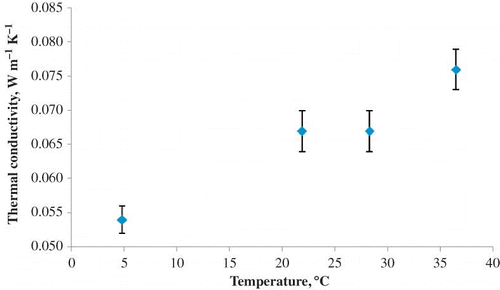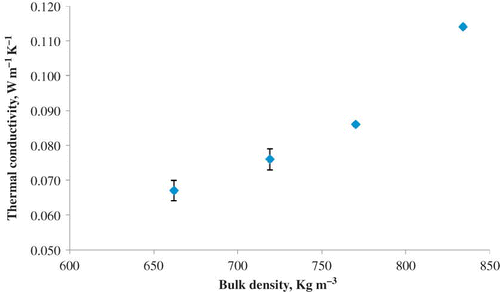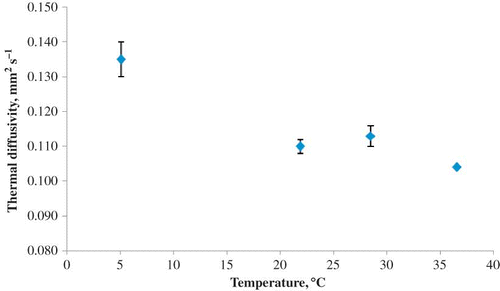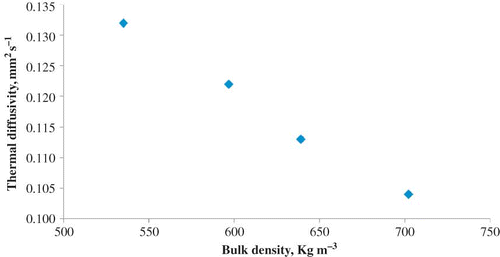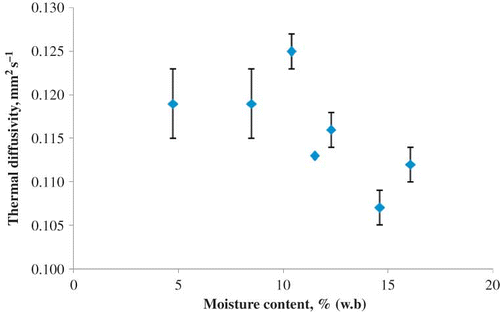Abstract
The thermal conductivity and thermal diffusivity for four types of rice flours and one type of rice protein were determined at temperatures ranging from 4.8 to 36.8 °C, bulk densities 535 to 875.8 kg m−3, and moisture contents 2.6 to 16.7% (w.b.), using a KD2 Thermal Properties Analyzer. The thermal conductivity of rice flours and rice protein increased with the increase in temperature, moisture content as well as with increase in bulk density. Thermal diffusivity decreased with increase in moisture content, increase in temperature and bulk density. The thermal conductivities values obtained were within the range of 0.045 to 0.124 W m−1 K−1 whereas the thermal diffusivity values were in the range of 0.094 to 0.138 mm2 s−1.
INTRODUCTION
Thermal treatments such as pasteurization, concentration, drying, cooling, sterilization, thawing, cooking and so on are frequently used in food processing, transportation, and preservation operations. Knowledge of thermal properties of foods is thus important not only for designing optimal processing systems but also for the prediction and control of various changes occurring in foods during thermal processing and storage. Precise data of thermal properties are required both for existing foods and for new products and processes. Besides processing and preservation, thermal properties also affect sensory quality of foods as well as energy savings from processing.Citation[1]
Thermal conductivity is defined as the ratio of heat flux density to temperature gradient in a food material. It measures the ability of a food material to conduct heat and this property can be used to predict or control heat flux in food during processing operations such as cooking, freezing, sterilization, drying or pasteurization.[1] Thermal diffusivity is the ratio of thermal conductivity to specific heat and is a measure of how fast heat diffuses through a food material. This property helps in estimating processing time of heating, cooling, freezing and cooking.[1] The thermal conductive and thermal diffusivity may be expressed as:
Thermal conductivity
where k = thermal conductivity (W m−1 °C−1), q is rate of heat flow (W), A is area of heat transfer normal to heat flow (m2), t is temperature ( °C), and x is thickness.
Thermal diffusivity
where, α is thermal diffusivity, m2s−1; k is thermal conductivity, W m−1 °C−1; Cp is specific heat capacity, kJ kg−1 °C−1and ρ is bulk density, kg m−3.
The effective thermal conductivities of defatted soy flourCitation[2] and wheat flourCitation[3] were measured at various moisture contents, temperatures, and bulk densities. Muramatsu et al.Citation[4] predicted the effective thermal conductivity, effective thermal diffusivity, and specific heat of wheat flour simultaneously from line heat source probe data and related these properties to moisture content and temperature. Qi et al.Citation[5] determined the thermal conductivities of four types of granular rice starches, regular, low protein, waxy and low protein waxy at bulk densities of 600 and 800 kg m−3, temperatures of 20, 50 and 80 °C, and moisture contents of 4, 20 and 40%. They found thermal conductivity increased significantly with increases in bulk density, temperature and moisture. Lan et al.Citation[6] used a line-heat resource probe system to determine the thermal properties of tapioca starch. Kim et al.Citation[7] measured the effective thermal conductivity of wheat flour milling co-products (bran, germ, shorts, and red dog). BožikováCitation[8] used an Isomet instrument for the measurement of thermal conductivity and thermal diffusivity of corn flour and wheat flour and related these thermal properties to moisture content and bulk density. Muramatsu et al.Citation[9] measured the effective thermal conductivity of rice flour at selected moisture contents, temperatures and bulk densities using transient heat probe method. The effects of moisture content, temperature, and bulk densities on the effective thermal conductivity of rice flour were investigated.
The transient heat probe method used by Muramatsu et al.[9] consisting of twin probes is a kind of relative measurement, and can measure thermal conductivity with high accuracy. In this method, the temperature changes of the probes inserted in the reference material and sample are simultaneously measured, and the effective thermal conductivity of the sample is calculated; whereas, a KD2 Thermal Properties Analyzer uses a transient line heat source or transient heated needle method. This analyzer gives direct readings of the thermal conductivity and thermal diffusivity using a smaller needle and a shorter heating time.
Though thermal properties of rough rice have been studied by several researchers, rice flour thermal properties have been very little studied to date. With the increasing quantity and variety of rice flours being produced by food industries, there is a need for information about their thermal properties. The objective of this study was to determine the thermal conductivity and thermal diffusivity of rice flour and rice protein at various moisture contents, temperatures, and bulk densities, by using a KD2 Thermal Properties Analyzer (Decagon Devices, Inc., Pullman, WA, USA).
MATERIALS AND METHODS
The thermal conductivity and thermal diffusivity of four kinds of rice flours and one type of rice protein were measured using the KD2 Thermal Properties Analyzer. The probe length was 60 mm and its diameter was 0.9 mm. This analyzer gives direct readings of thermal conductivity and thermal diffusivity. Five minutes gap was provided between each reading.
The brand names of the rice flour samples used in this study were RF-M01080-12 (California medium grain rice), RF-W01080-12 (specialty rice), RF-L00080-12 (all three from Sage V Foods, Freeport, TX), and King Arthur Flour (Baker's Catalogue, White River Junction, VT). The brand name of the rice protein was Brown Rice Protein (MLO Products Inc., Fairfield, CA).
Sample Handling
The flour was filled into a graduated cylinder and its bulk density was adjusted. The height of the sample was decreased by dropping the graduated cylinder from a constant height.[9] The jolting action consolidated the flour to the required bulk density which was determined from the weight of flour and the volume of the cylinder. Density measurement was done in 3 replicates.
The samples were conditioned to different moisture contents by drying or rewetting them. To obtain higher moisture content than the initial moisture content, predetermined amounts of distilled water was added to the sample thinly spread in the pan while mixing the sample. A maximum moisture content of 16.7% was used because at higher moisture contents, the flours may turn pasty and may not behave as a bulk solid.Citation[10] To achieve moisture content lower than the initial moisture content, the sample was thinly spread on a pan and the pan was put into an incubator controlled to 40 °C for about 5 h. The dried or remoistened sample was sealed in a polythene bag and stored at room temperature for 3 days before measurement.[9] To ensure a uniform distribution of moisture in the bag, the bag was mixed by rolling and shaking the contents periodically.
To obtain lower temperature, samples were kept in a cooler (2–4 °C) under airtight conditions (VWR, Model GDM-47, True Manufacturing Co., O'fallon, OR). For higher temperatures, samples were kept in an incubator (VWR, Model 1575, Sheldon Manufacturing, Inc., Cornel, OR) at 30 and 40 °C for 2 h.
Moisture content was determined using the AOAC method. Small aluminum pans were used in containing the sample for moisture determination. About 2 g of sample was taken and weighed (Mettler Toledo, Model A-250, Denver Instrument Co., Denver, CO). The sample mass before drying was recorded and the sample was heated in an electric oven (Lindberg/Blue, Model G01350SC, Blue M, Asheville, NC) at 102 °C for 16 h. Samples were taken out, immediately placed in a desiccator for 30 min and then weighed again.Citation[11] Moisture measurement was done in 3 replicates.
Equipment Calibration
The probe was calibrated in glycerol (C3H8O3) at room temperature. Three trials were carried out for the calibration process. The mean thermal properties of glycerol obtained by KD2 and data reported by RahmanCitation[12] were compared. Deviation was +4.9% for thermal conductivity, and +5.9% for thermal diffusivity. Based on these deviations, appropriate correction was made to the thermal conductivity and thermal diffusivity values that were obtained by the KD2.
Data Analysis
Data were analyzed using the ANOVA procedures of the Statistical Analysis System version 9.1.Citation[13] The differences were considered significant at p < 0.05.
RESULTS AND DISCUSSION
In case of rice flours, thermal conductivity and thermal diffusivity were determined at temperatures between 4.8 and 36.8 °C (four levels), moisture contents 4.8 and 16.7% (seven levels), and at bulk densities between 602.6 and 875.8 kg m−3 (four levels). For rice protein, thermal conductivity and thermal diffusivity were determined at temperatures between 5.4 and 36.5 °C (four levels), moisture contents 2.6 and 15.7% (w.b.), and at bulk densities between 535 and 702.3 kg m−3. The initial moisture contents and bulk densities were measured for all the samples (). All measurements were done in triplicates.
Table 1 Initial moisture content and bulk densities of the samples
Thermal Conductivity
Effect of temperature
It was found that thermal conductivity increased with increasing temperature () and the increasing temperature had a significant effect on thermal conductivity (p < 0.05). In case of rice flours, thermal conductivity increased from 0.045 W m−1 K−1 at 5.2 °C to 0.083 W m−1 K−1 at 36.6 °C. For rice protein, thermal conductivity increased from 0.05 W m−1 K−1 at 5.4 °C to 0.064 W m−1 K−1 at 36.5 °C. Thermal conductivity is affected by atomic activity, which depends on temperature.Citation[14] As the temperature of rice flour increased, there was higher atomic activity and the rice flour had greater ability to transfer heat; thus it had higher thermal conductivity.
Effect of bulk density
The thermal conductivity values were found to increase with bulk density () and the increasing bulk density had a significant effect on thermal conductivity (p < 0.05). The values increased from 0.066 W m−1 K−1 at 657.7 kg m−3 to 0.124 W m−1 K−1 at 837 kg m−3 for rice flours. In case of rice protein, thermal conductivity increased from 0.057 W m−1 K−1 at 535 kg m−3 bulk density to 0.085 W m−1 K−1 at 702.3 kg m−3. The thermal conductivity of rice flour depended on the presence of pores and air pockets among the rice flour particles. Since air has lower thermal conductivity than that for rice flour, higher porosity (i.e., lower bulk density) resulted in lower thermal conductivity. The effective thermal conductivity of the air-rice flour mixture increased with decreasing air content and increasing bulk density.
Effect of moisture content
Thermal conductivity increased from 0.057 W m−1 K−1 at 5% to 0.073 W m−1 K−1 at 16.7% moisture content in case of rice flours (). Increasing moisture content had a significant effect on thermal conductivity (p < 0.05). However, the results did not show any significant difference between 12.1 and 15.2% moisture contents. For rice protein, thermal conductivity increased from 0.054 W m−1 K−1 at 2.6% moisture content to 0.066 W m−1 K−1 at 15.7% moisture content. Increase of thermal conductivity with the increase in moisture content was also reported for corn and wheat flour.[8] The increasing trend was due to the increased quantity of water. More water resulted in a higher thermal conductivity of moisture rich rice flour.
Thermal Diffusivity
Effect of temperature
However, the thermal diffusivity was found to decrease with increase in temperature (). Increasing temperature had a significant effect on thermal diffusivity (p < 0.05). In case of rice flours, thermal diffusivity decreased from 0.138 mm2 s−1 at 5.2 °C to 0.103 mm2 s−1 at 36.8 °C. For rice protein, thermal diffusivity decreased from 0.132 mm2 s−1 at 5.4 °C to 0.119 mm2 s−1 at 36.5 °C. The influence of temperature on the thermal diffusivity of rice flour depended upon the corresponding influence on both the thermal conductivity and specific heat of rice flour. Due to the increase in temperature thermal conductivity values increased. But the specific heat values might have increased at a greater rate than the thermal conductivity values, resulting in the decrease in thermal diffusivity of rice flour.
Effect of bulk density
Similarly, thermal diffusivity decreased with bulk density (). It was found that increasing bulk density had a significant effect on thermal diffusivity (p < 0.05). In case of rice flours, it decreased from 0.113 mm2 s−1 at 662 kg m−3 to 0.094 mm2 s−1 at 875.8 kg m−3. In case of rice protein, thermal diffusivity decreased from 0.132 mm2 s−1 at 535 kg m−3 to 0.103 mm2 s−1 at 702.3 kg m−3. Similar trends of decrease in thermal diffusivity with the increase in bulk density were reported by Božiková[8] for corn and wheat flour. Due to the increase in bulk density, pores and air pockets within and among the rice protein particles were reduced and the thermal conductivity values increased. But the bulk density values might have increased at a greater rate than the thermal conductivity values, resulting in the decrease in thermal diffusivity of rice protein.Citation[14]
Effect of moisture content
It was observed that thermal diffusivity values decreased with moisture content as well (). Thermal diffusivity decreased significantly with increase in bulk density (p < 0.05). However, the results did not show any significant difference between 5 and 8% moisture contents and also between 15 and 16% moisture contents. For rice flours, they decreased from 0.122 mm2 s−1 at 5.2% to 0.106 mm2 s−1 at 16.7% moisture content. In case of rice protein, thermal diffusivity decreased from 0.129 mm2 s−1 at 2.6% to 0.119 mm2 s−1 at 15.7% moisture content. It could be possible that as pour spaces were filled with water, thermal diffusivity was reduced since the thermal diffusivity of liquid water was lower than that of air.Citation[15]
Similar patterns were observed for rice bran,Citation[16] wheat, corn, sorghumCitation[17] and African yam bean.Citation[18] In contrast, Božiková[8] reported that thermal diffusivity values increased with the increasing moisture contents in case of corn and wheat flour.
Comparison with Published Results
Very little research has been done on the thermal properties of rice flour. The ASABE StandardCitation[19] includes the thermal property values of cowpea, defatted soy, sorghum, and wheat flours; however, they are not documented for rice flour. The only work on rice flour that the authors could come across during the course of this investigation was that of Muramatsu et al.[9] and a comparison has been made between the results. For instance, Muramatsu et al.[9] reported that the thermal conductivity of rice flour was 0.074 W m−1 K−1 at 20 °C, 8.8% moisture content and 650 kg m−3 bulk density. In the present study at 21.9 °C, 8.7% moisture content and 621.4 kg m−3 bulk density, the thermal conductivity of rice flour (L-80) was found to be 0.073 W m−1 K−1.
CONCLUSION
The thermal conductivities and thermal diffusivities of four types of rice flours and one type of rice protein were measured by the KD2 Thermal Properties Analyzer at various temperatures, bulk densities and moisture contents. The thermal conductivity increased with increase in temperature, bulk density and moisture content in the ranges of 4.8 to 36.8 °C, 535 to 875.8 kg m−3, and 2.6 to 16.7%, respectively. The values obtained were within the range of 0.045 to 0.124 W m−1 K−1. The thermal diffusivity values obtained were in the range of 0.094 to 0.138 mm2 s−1. They found to decrease with increase in temperature, bulk density and moisture content as well.
ACKNOWLEDGEMENT
The authors would like to thank the Sage V Foods (Freeport, TX) for providing their rice flour samples for this research.
REFERENCES
- Fontana , A.J. , Varith , J. , Ikediala , J. , Reyes , J. and Wacker , B. 1999 . Thermal properties of selected foods using a dual needle heat-pulse sensor , Joseph, MI : ASABE Paper No. 996063, ASABE: St .
- Wallapapan , K. and Sweat , V.E. 1982 . Thermal conductivity of defatted soy flour . Transactions of the ASABE , 25 ( 5 ) : 1440 – 1444 .
- Muramatsu , Y. , Tagawa , A. , Kasai , T. , Takeya , K. and Fukushima , M. 2002 . Effective thermal conductivity of wheat flour . Journal of the Japan Society of Agricultural Machinery , 64 ( 1 ) : 70 – 76 .
- Muramatsu , Y. , Tagawa , A. , Kasai , T. , Sakai , H. and Fukushima , M. 1999 . Measurements of thermophysical properties of wheat flour by transient heat flow method using a probe . Journal of the Japan Society of Food Science and Technology , 46 ( 11 ) : 719 – 724 .
- Qi , F. , Lan , Y. , Kocher , M.F. and Hanna , M.A. 2000 . Thermal conductivity of granular rice starches . International Journal of Food Properties , 3 ( 2 ) : 283 – 293 .
- Lan , Y. , Fang , Q. , Kocher , M. and Hanna , M.A. 2000 . Thermal properties of tapioca starch . International Journal of Food Properties , 3 ( 1 ) : 105 – 116 .
- Kim , Y.S. , Flores , R.A. , Chung , O.K. , Bechtel , D.B. and Physical . 2003 . chemical, and thermal characteristics of wheat flour milling coproducts . Journal of Food Process Engineering , 26 ( 5 ) : 469 – 488 .
- Božiková , M. 2003 . Thermophysical parameters of corn and wheat flour . Research in Agricultural Engineering , 49 ( 4 ) : 157 – 160 .
- Muramatsu , Y. , Tagawa , A. and Kasai , T. 2005 . Effective thermal conductivity of rice flour and whole and skim milk powder . Journal of Food Science , 70 ( 4 ) : 279 – 287 .
- Kamath , S. , Puri , V.M. and Manbeck , H.B. 1994 . Flow property measurement using the Jenike cell for wheat flour at various moisture contents and consolidation times . Powder Technology , 81 : 293 – 297 .
- Meares , C.A. , Bogracheva , T.Y. , Hill , S.E. and Hedley , C.L. 2004 . Development and testing of methods to screen chickpea flour for starch characteristics . Starch/Stärke , 56 : 215 – 224 .
- Rahman , S. 1995 . Food Properties Handbook CRC Press, Boca Raton, FL
- SAS . 2003 . SAS Users’ Guide: Statistics , Raleigh, NC : Statistical Analysis System, Inc .
- Emami , S. , Tabil , L.G. and Tyler , R.T. 2007 . Thermal properties of chickpea flour, isolated chickpea starch, and isolated chickpea protein . Transactions of the ASABE , 50 ( 2 ) : 597 – 604 .
- Iguaz , A. , San Martin , M.B. , Arroqui , C. , Fernandez , T. , Mate , J.I. and Virseda , P.. 2003 . Thermophysical properties of medium grain rough rice (LIDO cultivar) at medium and low temperatures . European Food Research and Technology , 217 : 224 – 229 .
- Sreenarayanan , V.V. and Chattopadhyay , P.K. 1986 . Thermal conductivity and diffusivity of rice bran . Journal of Agricultural Engineering Research , 34 ( 1 ) : 115 – 121 .
- Jakendra , Y.R. , Thomas , R. , Rao , V.V. , Sherif , T. and Sreenarayanan , V.V. 1995 . Effect of moisture content on thermal diffusivity of grains . Agricultural Mechanization in Asia, Africa, and Latin America , 26 ( 3 ) : 49 – 50 . 54
- Irtwange , S.V. and Igbeka , J.C. 2003 . Influence of moisture content on thermal diffusivity and specific heat of African yam bean (Sphenostylis Stenocarpa) . Transactions of the ASABE , 46 ( 6 ) : 1633 – 1636 .
- ASABE . 2003 . “ Thermal properties of grain and grain products ” . In ASABE Standards , Joseph, MI : ASABE: St .
